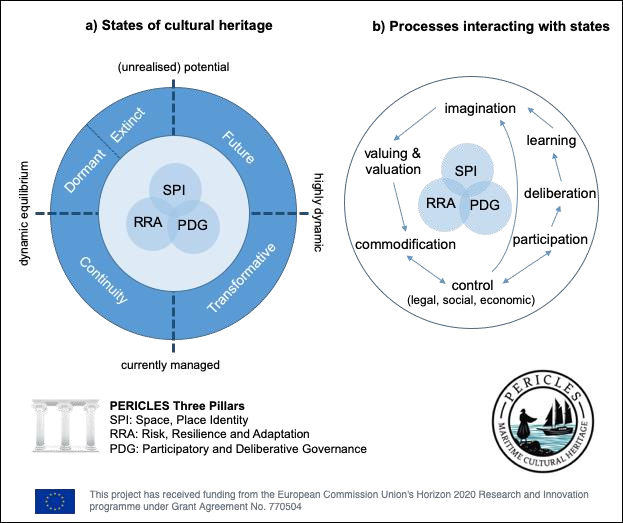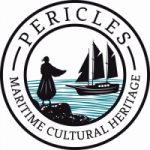
The PERICLES conceptual framework: three pillars to underpin transformative heritage

The PERICLES conceptual framework builds on current trends in cultural heritage resilience research, which suggests that key to resilience in cultural heritage is to regard heritage as non-static, and within Coastal and Maritime Cultural Heritage (CMCH) we must adapt, create networks, remove boundaries and share resources. This fits with anthropological understanding that culture is structurally embedded in people’s lives, practices, social institutions et cetera, but it is also continually changing. By adopting dynamic perspectives and tailoring management approaches to reflect them, cultural heritage is best prepared for responding to the shocks and stresses it faces in the present and future.
These understandings of CMCH as dynamic and changeable, rather than static, open up the way to thinking about more transformative approaches to understanding, conserving and exploiting CMCH for social benefit, and this allows us to develop a spectrum of CH approaches between on the one hand preservation to provide continuity, based on traditional understandings and uses, deemed important now and in the future; and, on the other hand, a more transformative approach that challenges the status quo, is explicitly inclusive of deliberation by diverse social groups and questions of heritage justice, and looks for resilience by allowing heritage objects to adapt, evolve and transform in a way that does justice to diverse social values and needs in the present and the future.
Continuity heritage focuses on providing continuity to heritage but in doing so, it also provides with a sense of cultural continuity to communities, but also society as a whole; in contrast, transformative heritage can both be transformed itself, but also has the potential to impact on society in a transformative way. This spectrum follows a parallel in recent resilience literature where resilience is characterised by a spectrum between mindsets and approaches focused on defending the status quo (survival resilience), to being resilient through pro-actively responding to change through a process of social deliberation (transformative resilience). In addition to continuity heritage and transformative heritage, we identify future, dormant and extinct states of heritage.
Three pillars
Our approach to managing and preserving cultural heritage builds on three theoretical pillars:
- Space, Place, and Identity;
2. Risk, Resilience, and Adaption; and
3. Deliberative and Participatory Governance.
Space, place, and identity
PERICLES explores the different ways that spaces become places and influence identities. We also focus on tangible cultural heritage, which has value both for what it is and for what it alludes to; by being visible, it draws attention to the intangible in terms of the cultures, societies and circumstances that shaped landscape use and exploitation. Both tangible and intangible cultural heritage are important for creating a sense of individual and societal identity.
Risk, resilience and adaptation
Coastal areas experience intense and sustained pressures from a diverse range of social and environmental sources, all of which have the potential to become risks to the preservation and utilisation of cultural heritage. Our coasts host many of the EU’s major centres of commerce and are subject to the attendant pressures that emanate from these cities (e.g. urban sprawl and rapid development).
Due to globalisation and resulting MacDonaldisation of cities, many urban centres are at risk of losing their inherent uniqueness as waterfronts and high streets are increasingly designed to resemble each other and are disembedded from their coastal heritage.
Risk, resilience and adaptation challenges vary according to specific threats and contexts and therefore require different solutions. This is explored in PERICLES in demos that include, for example, adaption in the face of climate change challenges (Malta and Wadden Sea), the challenges associated with growing demands onmaritime and coastal resources though Blue Growth (Scotland and Denmark) and challenges to traditional ways of life (Estonia, Malta, Aegean).
Deliberative and participatory governance
Participation is essential in governing both cultural heritage and landscapes to guarantee the integration of diverse knowledge, values and perspectives, ensure recognition of all salient risks, avoid or reduce conflict and find synergies between different interests, and broadly improve the quality of decisions. Governance is about the rules of collective decision-making. Governance and developments in participation can be linked to the notion of ‘deliberative democracy’ and empowered participatory governance. PERICLES will provide a comprehensive, empowered participatory governance framework for sustainable management and conservation of European coastal and maritime cultural landscapes, to assess and mitigate risks and integrate knowledge across local, spatial, environmental, social and economic aspects of CH.
